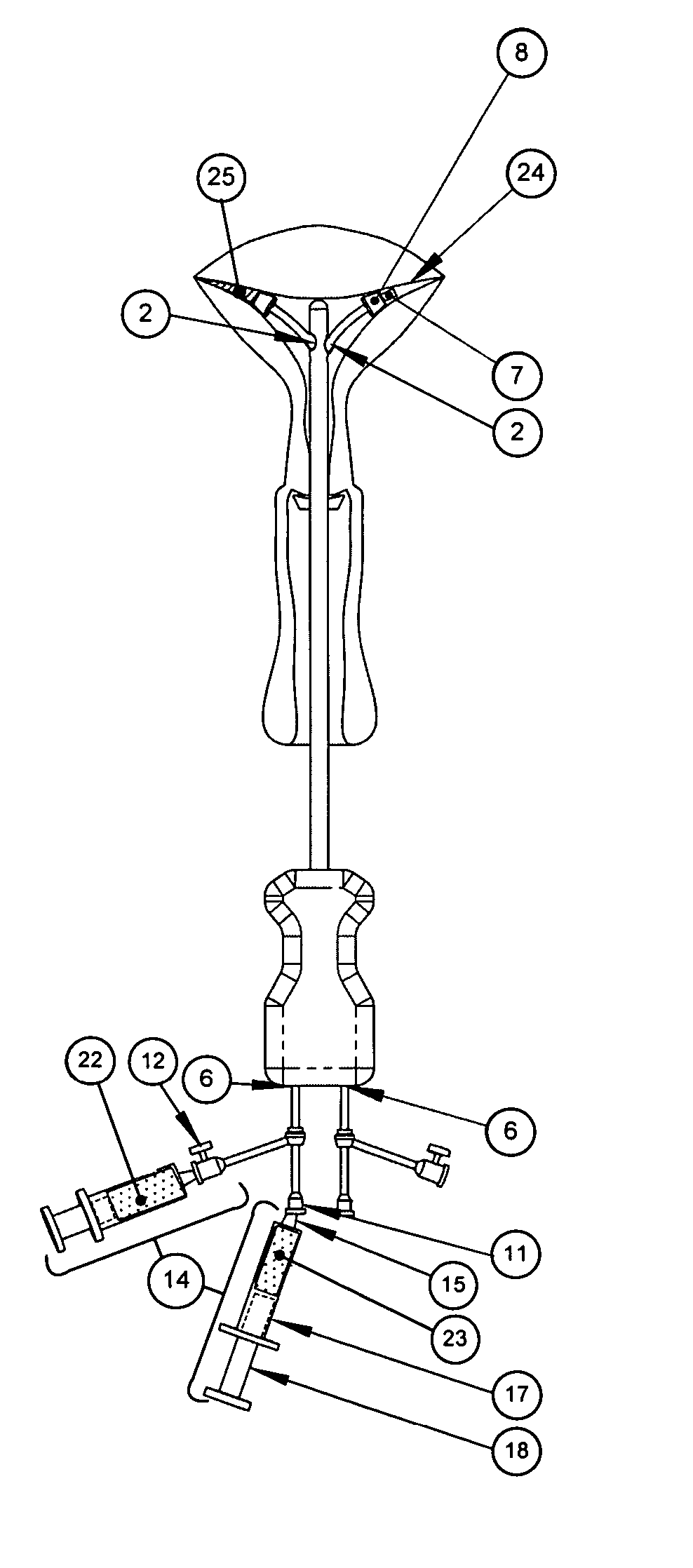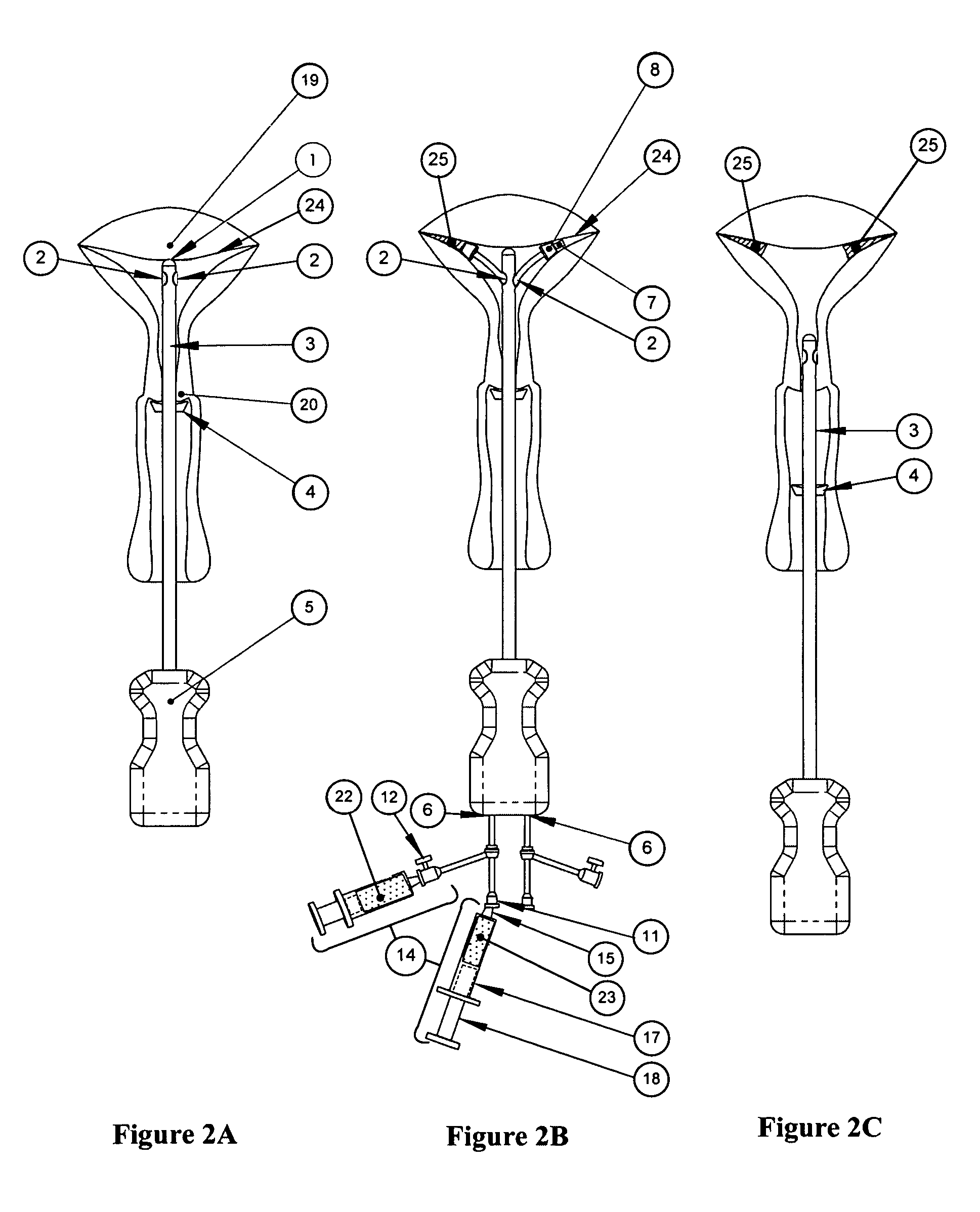Methods and devices for conduit occlusion
a technology of occlusion and conduit, which is applied in the direction of prosthesis, catheter, surgery, etc., can solve the problems of many occlusion techniques that are harmful or potentially harmful, are not reversible, and are not suitable or safe for a number of women, and none of the current options meet these requirements
- Summary
- Abstract
- Description
- Claims
- Application Information
AI Technical Summary
Problems solved by technology
Method used
Image
Examples
example 1
Preparation of Implantable Material A
[0120] A solution of 25 / 75 poly lactide-co-ε-caprolactone (PLCL) was prepared 50% by weight in n-methyl-pyrrolidone (NMP) and sterilized. A mixture of 2-methoxypropyl cyanoacrylate (MPCA) with a biocompatible acid, in this case glacial acetic acid (AA), was prepared containing approximately 1 part MPCA and 1 part AA and sterilized. Implantable material A was prepared immediately prior to use by mixing 0.8 cc PLCL solution with 0.2 cc MPCA mixture until homogeneity of the mixture was achieved. The resultant mixture initially warms indicative of curing but remains adhesive to tissue and flowable through a 20G IV catheter for at least 15 min at room temperature in the absence of an aqueous environment. In contact with either water or animal tissue, the implantable material completes its curing quickly, forming a semi-solid material that is compressible and flakes relatively easily.
example 2
Preparation of Implantable Material B
[0121] A solution of 50 / 50 poly lactide-co-glycolide (PLGA) was prepared 25% by weight in ethyl alcohol (EtOH) and sterilized. A mixture of butyl cyanoacrylate (BCA) with AA was prepared containing approximately 2 parts BCA and 1 part AA and sterilized. Implantable material B was prepared immediately prior to use by mixing 0.4 cc PLGA solution with 0.4 cc BCA mixture until homogeneity of the mixture was achieved. The resultant mixture initially warms indicative of curing but remains strongly adhesive to tissue and flowable through a 20G IV catheter for at least 15 min at room temperature in the absence of an aqueous environment. In contact with either water or animal tissue, the implantable material completes its curing quickly, forming a relatively incompressible semi-solid material that fractures on attempted bending.
example 3
Preparation of Implantable Material C
[0122] Particles of 50 / 50 PLGA were prepared by dissolving PLGA in methylene chloride to create a 25% weight / volume solution, emulsifying in a 0.3% polyvinyl alcohol (PVA) solution, and further addition of PVA solution with 2% isopropyl alcohol to remove solvent. Particles were collected, lyophilized, and sterilized. Particles (0.25 g) were added to 0.75 g of a sterilized mixture containing 2 parts BCA and one part AA. The resulting particulate suspension was flowable at room temperature but cured on contact with water or animal tissue, forming a stiff, adherent material.
PUM
 Login to View More
Login to View More Abstract
Description
Claims
Application Information
 Login to View More
Login to View More - R&D
- Intellectual Property
- Life Sciences
- Materials
- Tech Scout
- Unparalleled Data Quality
- Higher Quality Content
- 60% Fewer Hallucinations
Browse by: Latest US Patents, China's latest patents, Technical Efficacy Thesaurus, Application Domain, Technology Topic, Popular Technical Reports.
© 2025 PatSnap. All rights reserved.Legal|Privacy policy|Modern Slavery Act Transparency Statement|Sitemap|About US| Contact US: help@patsnap.com



